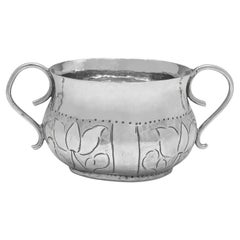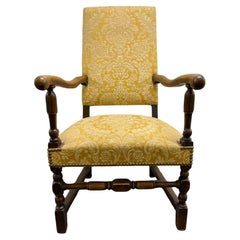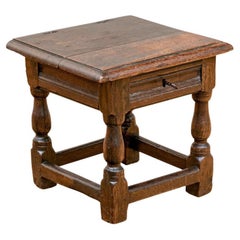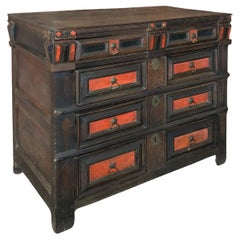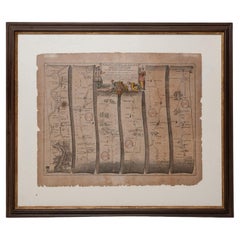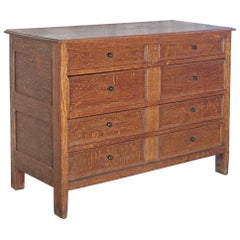Charles II Furniture
to
24
83
46
128
4
2
196,855
114,803
44,096
33,051
16,210
12,148
10,892
10,838
9,955
8,920
7,327
6,609
6,521
6,381
6,215
6,109
4,933
3,753
105
10
13
6
7
2
2
1
2
1
1
2
92
65
39
17
14
118
108
81
4
2
134
131
134
5
1
1
1
1
Style: Charles II
17th Century Charles II period sterling silver porringer hallmarked London 1669
Located in London, London
Hallmarked in London in 1669, this handsome, Charles II period, Antique Sterling Silver Porringer, is of traditional form with chased and engraved detailing. The makers mark T.P is s...
Category
1660s English Antique Charles II Furniture
Materials
Sterling Silver
Charles II Walnut Elbow Chair
Located in Basildon, GB
A Charles II walnut elbow chair with foliate carved scrolling arms. The rectangular back and seat covered in modern needlework authentically styled to the period.
Category
1680s British Antique Charles II Furniture
Materials
Walnut
19C Oak Charles II Flip Top Joint Stool
Located in Bridgeport, CT
Charles II flip top side table or stool with planked hinged lid secured with exposed carter-pin type hardware, interior lid and box lined with old newspaper, carved apron, exposed pe...
Category
17th Century English Antique Charles II Furniture
Materials
Oak
English Charles II Oak partly stained 17th Century Commode
Located in Troy, NY
English Charles II Oak and partly stained 17th Century Commode
Made ca. 1670 likely in Dorset, the thin two-board top over four drawers, the drawer fronts accentuated by red and blac...
Category
Late 17th Century English Antique Charles II Furniture
Materials
Oak
Road Map Britannia No 25 London to the Lands End, John Ogilby Brown Gilded Frame
By John Ogilby
Located in BUNGAY, SUFFOLK
The road from London to the lands end. Commencing at the Standard in Cornhill and extending to Senan in Cornwall. By John Ogilby His Majesties Cosmographer. A road map from Britannia, 1675/6. No 25.
Continuing 308 miles, 3 furlongs.
London Southwark to Brentford, to Hampton Court, to Hounslow, to Windsor, to Cobham, to Farnham, to Basingstoke to Winchester
The handcoloured sheet free floated. In a brown painted and gilded, ogee moulded frame. Some foxing and creasing, uneven edge of sheet, all commensurate with age
Provenance : purchased as pair from a collector with no 15 London to St David's. Framed as a pair.
Sheet width 48cm., 19 ”., height 38cm., 15 “
Frame width 66.5cm., 26”., height 56cm., 22 ”
In a remarkable life John Ogilby pursued, several careers, each ending in misfortune, and yet he always emerged undeterred, to carry on. His modern reputation is based on his final career, started i
Black Linear Border around Map Length 44cm., 17 1/8" Height 32cm., 12 1/2"
Full Sheet Length 58cm., 22 3/4" Height 38cm., 15"
Frame Length 66cm., 26"., Height 56cm., 22"
In a remarkable life John Ogilby pursued, several careers, each ending in misfortune, and yet he always emerged undeterred, to carry on. His modern reputation is based on his final career, started in his sixty-sixth year, as a publisher of maps and geographical accounts.
Ogilby was born outside Dundee, in 1600, the son of a Scottish gentleman. While he was still a child, the family moved to London. When the elder Ogilby was imprisoned for debt, the young John invested his savings in a lottery, won a minor prize, and settled his father's debts. Unfortunately, not enough money was left to secure John a good apprenticeship; instead, he was apprenticed to a dance master. Ogilby was soon dancing in masques at court but, one day, while executing a particularly ambitious leap, he landed badly. The accident left him with a permanent limp, and ended his dancing career. However, he had come to the attention of Thomas Wentworth, later Earl of Strafford, Charles I's most senior minister. Ever one to exploit his contacts, Ogilby became a dance instructor in Strafford's household.
When Strafford was sent to Ireland, Ogilby accompanied him as Deputy-Master of the Kings Revels, and then Master of Revels. In Dublin, he built the New Theatre, in St. Werburgh Street, which prospered at first, but the Irish Rebellion, in 1641, cost Ogilby his fortune, which he estimated at £2,000, and almost his life. After brief service as a soldier, he returned to England, survived shipwreck on the way, and arrived back penniless.
On his return, Ogilby turned his attention to the Latin classics, as a translator and publisher. His first faltering attempt, in 1649, was a translation of the works of Virgil, but after his marriage to a wealthy widow the same year, his publishing activities received a considerable boost. One means by which Ogilby financed these volumes was by subscription, securing advance payments from his patrons, in return for including their name and coats-of-arms on the plates of illustrations. Another approach was to secure a patron, preferably in the court circle. Ogilby's first patron was Strafford, who found out too late that all leading ministers are dispensable when Charles I assented to his execution in 1641. As he re-established himself, Ogilby sought a new patron, the King himself.
In 1661, Ogilby was approached to write poetry for Charles II's coronation procession; he later published 'The Relation of His Majesties Entertainment Passing Through the City of London', and a much enlarged edition the following year, which included a fine set of plates depicting the procession. Royal favour was bestowed in 1674 when John Ogilby received the title of 'His Majesty's Cosmographer and Geographick Printer' with a salary of £13.6s.8d per annum.
In 1665, Ogilby left London to avoid the Plague then ravaging the capital. The following year, in the Great Fire of London, Ogilby claimed that he lost his entire stock of books valued at some £3,000, as well as his shop and house, leaving him worth just £5.
As he sought to restore his fortunes, Ogilby was already looking in new directions. The initial opportunity he seized on was the reconstruction of London's burnt-out centre. He secured appointment as a "sworn viewer", whose duty was to establish the property boundaries as they existed before the Fire. Ogilby was assisted in the project by his step-grandson, William Morgan...
Category
Late 17th Century British Antique Charles II Furniture
Materials
Paper
English late 17th Century Blond Oak commode / Chest of Drawers
Located in Troy, NY
English chest of drawers, Charles II, late 17th century, made of blond oak and left un-stained, which gives this commode a striking, unique "honey" color. The thin molded top sits a...
Category
Late 17th Century English Antique Charles II Furniture
Materials
Oak
Charles II Moulded Front Oak Chest of Drawers
Located in Bradford-on-Avon, Wiltshire
A Charles II 17 century oak chest with moulded front drawers, snakewood and bog oak panels and turned spindles and applied designs down each side. The top four drawers are half width...
Category
1660s English Antique Charles II Furniture
Materials
Oak
Pair of Charles II Hand Carved Walnut Armchairs
Located in West Sussex, Pulborough
We are delighted to offer for sale this stunning pair of Charles 2nd high walnut armchairs circa 1900. Beautifully carved and shaped frame with angels, flo...
Category
Early 1900s English Antique Charles II Furniture
Materials
Walnut
$2,122 Sale Price / set
20% Off
Road Map No43 London to Kings Lynn, Royston to Downham, John Ogilby, Britannia
By John Ogilby
Located in BUNGAY, SUFFOLK
John Ogilby (British 1600-1676) Cosmographer and Geographick Printer to Charles II.
A road map from Britannia, 1675/6. The road from London to Kings Lynn, showing Royston to Downham. In oak and gilded frame.
In a remarkable life John Ogilby pursued, several careers, each ending in misfortune, and yet he always emerged undeterred, to carry on. His modern reputation is based on his final career, started in his sixty-sixth year, as a publisher of maps and geographical accounts.
Ogilby was born outside Dundee, in 1600, the son of a Scottish gentleman...
Category
Late 17th Century British Antique Charles II Furniture
Materials
Paper
JAMES NORTHCOTE 1480-1517 PAiNTINGS PRINCESS BRIDGET & MARRIAGE OF SHREWSBURY
Located in West Sussex, Pulborough
Royal House Antiques is delighted to offer for sale this stunning pair of 16th to 17th century, miniature oil paintings which are after the originals by James Northcote (1480-1517) t...
Category
17th Century English Antique Charles II Furniture
Materials
Giltwood
Charles II Oak Chest of Drawers Late 17th/Early 18th Century. Great color
Located in Buchanan, MI
A Charles II Oak Chest of Drawers
Late 17th/Early 18th Century. Great piece in both traditional and contemporary settings.
Height 35 x...
Category
17th Century English Antique Charles II Furniture
Materials
Oak
Pair of Huge Original Circa 1660 Pierre Mignard '1612-1695' Copper Plate Prints
By Pierre Mignard
Located in West Sussex, Pulborough
We are delighted to offer this exquisite pair of extra large Burr Satinwood framed copper plate prints dating to circa 1660 by the genius that was Pierre Mignard...
Category
1660s English Antique Charles II Furniture
Materials
Paper
Pair of Charles II Style Armorial Firedogs
Located in Brighton, West Sussex
A pair of Charles II style, enamel brass and cast iron armorial firedogs, in the manner of Anthony Hatch and Stephen Pilcherd.
Each firedog is decorated with red, blue and white enamel, the upperpart bearing the arms of Charles II or James II, the middle part formed of two nude male figures supporting the arms with a vase of flowers between them, the lower portions in the form of two convex disks decorated with flowers, with wrought iron supports.
They are modelled after an example in the collections of the Victoria & Albert Museum, London, formerly belonging to the Earl of Cowley. For a long time, their method of production -whereby the fields to be enameled were cast in the original moulds and not, as was more common, engraved (champlévé) or enclosed (cloisonné) - was referred to as Surrey Enamels after the author Charles R. Beard ascribed their manufacture to a factory in Esher, Surrey. However, documentary evidence makes a strong case for their reattribution to the London workshops of Anthony Hatch and Stephen Pilcherd, members of the Armourers' and Braziers' Company (see C. Blair and A. Petterson, 'Details for Surrey Enamels Reattributed (Part 1)', Journal of the Antique Metalware...
Category
19th Century English Antique Charles II Furniture
Materials
Brass, Enamel, Iron
Road Map Britannia No 15 London to St Davids John Ogilby Brown Gilt Frame
By John Ogilby
Located in BUNGAY, SUFFOLK
The continuation of the road from London to St Davids, commencing at Abingdon Com Berks and extending to Monmouth By John Ogilby Esq, His Majesties Cosmographer. From Abingdon to Farringdon, to Lechlade, to Fairford, to Barnsley to Gloucester showing Monmouth as the destination. A road map from Britannia, 1675/6. No 15.
Hand coloured and floated on a cream mount within a brown painted and gilded ogee frame. Some foxing and creasing, uneven edge of sheet, all commensurate with age
Provenance : purchased as pair from a collector with no 25 London to Lands End. Framed as a pair.
Sheet width 46.5cm., 18 ¼ ”., height 37.5cm., 14 ¾ “
Frame width 66.5cm., 26”., height 56cm., 22 ”
In a remarkable life John Ogilby pursued, several careers, each ending in misfortune, and yet he always emerged undeterred, to carry on. His modern reputation is based on his final career, started in his sixty-sixth year, as a publisher of maps and geographical accounts.
Ogilby was born outside Dundee, in 1600, the son of a Scottish gentleman. While he was still a child, the family moved to London. When the elder Ogilby was imprisoned for debt, the young John invested his savings in a lottery, won a minor prize, and settled his father's debts. Unfortunately, not enough money was left to secure John a good apprenticeship; instead, he was apprenticed to a dance master. Ogilby was soon dancing in masques at court but, one day, while executing a particularly ambitious leap, he landed badly. The accident left him with a permanent limp, and ended his dancing career. However, he had come to the attention of Thomas Wentworth, later Earl of Strafford, Charles I's most senior minister. Ever one to exploit his contacts, Ogilby became a dance instructor in Strafford's household.
When Strafford was sent to Ireland, Ogilby accompanied him as Deputy-Master of the Kings Revels, and then Master of Revels. In Dublin, he built the New Theatre, in St. Werburgh Street, which prospered at first, but the Irish Rebellion, in 1641, cost Ogilby his fortune, which he estimated at £2,000, and almost his life. After brief service as a soldier, he returned to England, survived shipwreck on the way, and arrived back penniless.
On his return, Ogilby turned his attention to the Latin classics, as a translator and publisher. His first faltering attempt, in 1649, was a translation of the works of Virgil, but after his marriage to a wealthy widow the same year, his publishing activities received a considerable boost. One means by which Ogilby financed these volumes was by subscription, securing advance payments from his patrons, in return for including their name and coats-of-arms on the plates of illustrations. Another approach was to secure a patron, preferably in the court circle. Ogilby's first patron was Strafford, who found out too late that all leading ministers are dispensable when Charles I assented to his execution in 1641. As he re-established himself, Ogilby sought a new patron, the King himself.
In 1661, Ogilby was approached to write poetry for Charles II's coronation procession; he later published 'The Relation of His Majesties Entertainment Passing Through the City of London', and a much enlarged edition the following year, which included a fine set of plates depicting the procession. Royal favour was bestowed in 1674 when John Ogilby received the title of 'His Majesty's Cosmographer and Geographick Printer' with a salary of £13.6s.8d per annum.
In 1665, Ogilby left London to avoid the Plague then ravaging the capital. The following year, in the Great Fire of London, Ogilby claimed that he lost his entire stock of books valued at some £3,000, as well as his shop and house, leaving him worth just £5.
As he sought to restore his fortunes, Ogilby was already looking in new directions. The initial opportunity he seized on was the reconstruction of London's burnt-out centre. He secured appointment as a "sworn viewer", whose duty was to establish the property boundaries as they existed before the Fire. Ogilby was assisted in the project by his step-grandson, William Morgan...
Category
Late 17th Century British Antique Charles II Furniture
Materials
Paper
Charles Ii furniture for sale on 1stDibs.
Find a broad range of unique Charles II furniture for sale on 1stDibs. Many of these items were first offered in the 21st Century and Contemporary, but contemporary artisans have continued to produce works inspired by this style. If you’re looking to add vintage furniture created in this style to your space, the works available on 1stDibs include case pieces and storage cabinets, seating, serveware, ceramics, silver and glass and other home furnishings, frequently crafted with wood, oak and other materials. If you’re shopping for used Charles II furniture made in a specific country, there are Europe, United Kingdom, and England pieces for sale on 1stDibs. While there are many designers and brands associated with original furniture, popular names associated with this style include Georg Andrea Bockler, Richard Blome, Charles & Richard Comyns, and Christopher Lawrence. It’s true that these talented designers have at times inspired knockoffs, but our experienced specialists have partnered with only top vetted sellers to offer authentic pieces that come with a buyer protection guarantee. Prices for furniture differ depending upon multiple factors, including designer, materials, construction methods, condition and provenance. On 1stDibs, the price for these items starts at $75 and tops out at $121,160 while the average work can sell for $4,888.
Recently Viewed
View AllMore Ways To Browse
Book Table Stand
Brands Of Vintage Glass
Brass Heron Sculpture
Bread Cabinet
Bronze Lalanne
Burl Bedside Chests
Burled Walnut Desk
Burnished Bamboo
Butter Table
Cabinet Dowel
Cabinets With Metal Inlay
Cameo Glass Bowl
Campaign Chest 1970
Campaign Chest Camphor
Canopic Jars
Canton Chinese Bowl
Cardinal Sculpture
Carrera Marble Dining Table
